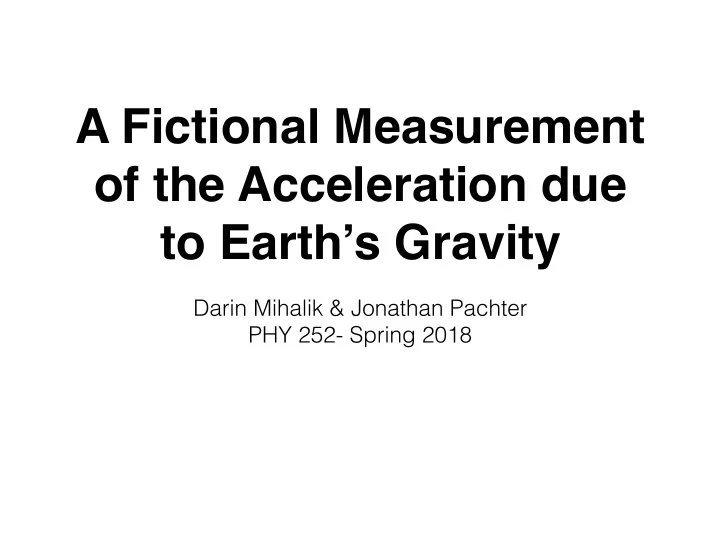

A Fictional Measurement of the Acceleration due to Earth’s Gravity Darin Mihalik & Jonathan Pachter PHY 252- Spring 2018
Motivation of Experiment The goal of every experiment is to test a hypothesis • In this experiment we want to measure the acceleration • due to gravity (or our hypothesis for the law governing the change of velocity per time) • We therefore need to know the time it takes an object to travel a known distance under the influence of gravity Our experiment will consist of dropping an object from • a specific height and recording the time from release until it hits the ground
Setup of the Experiment You will drop a massive object in a 10 meter long • vacuum tube (neglect air resistance) You precisely know the position of the markers (no • uncertainty in the position) You will measure the time from release to when the • object passes each successive meter mark You measure time with a stopwatch and therefore, • this measurement has uncertainty Each time measurement has the same uncertainty •
Recorded Data
Analysis We said before the goal of every experiment is to test • a hypothesis • Now that we collected data we want to see if it agrees with the hypothesis • The first step is to see what is predicted by theory and then to analyze our results and compare to the data We will see that manipulating the equations to • resemble a straight line is the best practice for analysis
Finding the Fit Parameters Clearly, we want to fit the data to a line with the form So we need to solve for the A, B and their uncertainties and we do this by a method called “least-squares fitting”.
Analysis We are looking to solve the theory (the time) as a straight line To have as a straight line we take the log of both sides Therefore, by comparison to We find the following for our parameters
Finding the Intercept “A” To calculate the intercept of the best fit line where where each sum is obviously treated as
Finding the Slope “B” To calculate the slope of the best fit line where again The uncertainties in these values are also calculated from known least-squares equations.
Uncertainties in Fit Parameters The uncertainty in the intercept of the best fit line The uncertainty in the slope of the best fit line
Chi-Squared For a linear fit, the chi-squared value is given by I will spare you the theory but this value is essentially a the “goodness-of-fit” parameter. It tells us how likely that our observed data points come from the parent distribution (a model), which is a line in this case. A “good fit” is usually one where the reduced chi- squared value is less than or equal to one
Recommend
More recommend